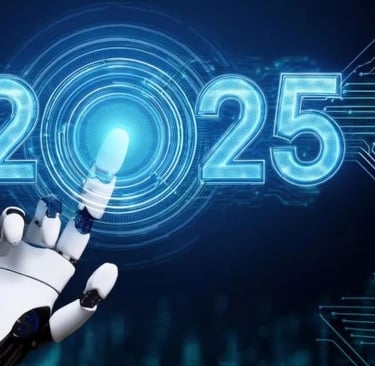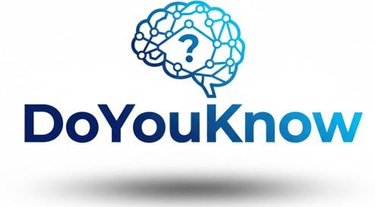Do You Know Why 2025 Is Being Called the ‘Year of AI in Daily Life’
Discover why 2025 is the ‘Year of AI in Daily Life’ — from smarter homes and faster healthcare to personalized learning and workplace automation that quietly transformed how we live.
TECH & SCIENCE
Do You Know Team
8/10/20255 min read


If you woke up this morning to a coffee brewed to your preferred strength, a calendar that rearranged itself around your traffic delays, and a short, AI-generated news summary on your phone — you experienced AI working in your daily life. Ten years ago, such conveniences were the stuff of sci-fi; now they are ordinary.
In 2025, artificial intelligence stopped being a specialist tool for engineers and became a background assistant for millions. It’s not just chatbots or novelty apps: AI is running behind household devices, powering medical alerts, shaping what we watch, and helping students learn at their own pace. People call this year the “Year of AI in Daily Life” because the technology moved from experimental to ubiquitous — quietly changing routines, choices, and expectations. This article explains how and why that happened, shows real-world examples, and answers the common questions readers are asking.
1. AI at Home: Comfort That Anticipates You
Smart homes used to mean timers and smart bulbs. In 2025, AI-driven systems predict needs. Your thermostat learns not just your schedule but your mood patterns and adjusts lighting and temperature accordingly. Refrigerators track what you’re low on and suggest recipes based on what’s left inside. For many families, everyday friction — “What should I cook?” or “Did I leave the stove on?” — is reduced or gone.
These systems also reduced routine cognitive load for people who manage households and caregiving responsibilities. For elderly people or those with chronic conditions, AI-enabled home devices provide reminders for medication, detect abnormal movement patterns, and can connect to caregivers automatically.
2. AI at Work: From Repetition to Creative Focus
At work, AI took over repetitive, time-consuming tasks: scheduling, basic data processing, first-draft reports, and routine customer replies. That shift let people reclaim hours for higher-value work: brainstorming, mentoring, relationship-building, and strategy.
Small teams and solo founders saw outsized benefits: AI tools that summarize meetings, extract next steps, and draft follow-ups replaced manual note-taking. That doesn’t mean jobs vanished overnight — roles evolved. Many professionals moved into oversight, interpretive, or curational roles, supervising AI outputs and adding human judgment where it matters.
3. AI in Healthcare: Early Warnings and Personalized Care
Healthcare saw some of the most visible benefits. Wearables and phone apps combined sensors, lifestyle data, and AI models to pick up subtle signs of trouble — a heart rhythm change, an early respiratory pattern, or sleep anomalies that preceded illness. That allowed clinicians to intervene earlier, and patients to avoid emergency-level exacerbations.
Remote monitoring and AI-assisted triage made routine care more accessible, especially in areas with doctor shortages. AI didn’t replace doctors; it extended their reach and helped prioritize urgent cases.
4. AI in Education: Learning That Adapts to You
Classrooms changed. Instead of one syllabus for thirty students, AI lesson systems created adaptive learning paths. A student struggling with a math concept received targeted practice and visual explanations; another accelerated through project-based work. Teachers used AI to spot gaps, personalize homework, and spend more class time on discussion and critical thinking.
For adult learners and professionals, AI offered micro-learning snippets that fit into commutes and breaks, helping people reskill faster.
5. AI in Entertainment & Creativity: Co-Creation Becomes Normal
Streaming and gaming services used AI to personalize experiences at scale. Recommendation systems evolved from “you may like” to “this moment is likely to delight you,” sometimes even changing storylines dynamically. Creators used AI companions to draft plots, generate visuals, or compose backing tracks — accelerating production and letting human creators iterate faster.
This created a new creative loop: humans set goals and aesthetics, AI speeds iteration, and audiences enjoyed more frequent, tailored entertainment.
6. AI in Mobility & Cities: Smarter, Safer Travel
AI improved traffic flows by coordinating traffic lights, routing public transit, and smoothing ride-share demand. Autonomous shuttles operated in controlled urban corridors, cutting commute times and reducing low-severity accidents. Traffic prediction tools nudged drivers toward less-congested routes, and city planners used anonymized AI insights to redesign problematic intersections.
7. The Human Side: Ethics, Trust, and Everyday Decisions
For wide AI adoption to stick, trust had to improve. In 2025, providers prioritized transparency, user controls, and data-minimization: people could see why an AI suggested something, adjust the degree of automation, and choose whether their data is stored. That human-centered approach — controls, explainability, and opt-ins — made many users comfortable trusting AI in daily decisions.
Regulations and industry standards also matured, making it clearer what AI systems could and couldn’t do and holding firms accountable when things went wrong.
8. Economic and Social Shifts
With routine tasks automated, industries restructured. Some traditional entry-level roles changed in nature, requiring new skills (e.g., AI oversight, prompt design, and data ethics). At the same time, many new roles emerged: AI trainers, domain verifiers, human-in-the-loop moderators, and ethical auditors. Societies faced a learning curve but also an opportunity: better productivity meant more time for caregiving, creativity, and local community projects.
9. Real Stories: How AI Touched Everyday People
A father in Mumbai used an AI coach to monitor his son’s asthma, receiving alerts when air quality and activity suggested risk — the family avoided several hospital trips that year.
A small bookstore owner used AI to predict what local customers wanted next month, ordering smarter and reducing unsold stock. That alone improved margins enough to hire a part-time assistant.
A college student improved test scores by using AI-powered study plans that identified weak topics and created targeted practice.
These simple, human stories illustrate the practical, non-glamorous benefits that make AI “part of life” instead of a tech novelty.
Frequently Asked Questions (FAQ)
Q1: What exactly changed in 2025 that makes AI part of daily life?
A: Several things converged — more reliable AI models, better device integration, clearer privacy rules, and lower hardware costs. Those factors made stable, useful AI features affordable and available on everyday devices.
Q2: Will AI take my job?
A: AI automates routine tasks, but it also creates new roles and shifts job focus toward oversight, strategy, and skills that require human judgment. Upskilling and adapting are the practical responses.
Q3: Is AI safe to use at home and for health decisions?
A: Many AI systems now include transparency features and allow users control over data and automation levels. For medical decisions, AI is a support tool; doctors still make final clinical judgments.
Q4: How does AI affect privacy?
A: Privacy depends on product design and policy. In 2025, many products default to minimizing stored personal data and offer clearer consent mechanisms — but users should still review settings and permissions.
Q5: How can I start using AI safely in my day-to-day life?
A: Start small: use a trusted AI assistant for scheduling or summaries, enable privacy controls, and gradually explore health or home automation features from reputable providers. Always verify critical information with experts.
Conclusion
The label “Year of AI in Daily Life” fits because 2025 saw AI stop being an optional gadget and become a quietly dependable partner in everyday routines. Across homes, workplaces, health systems, schools, and cities, AI made tasks simpler, outcomes better, and choices quicker. The technology’s win wasn’t spectacle — it was usefulness: solving small frictions repeatedly, reliably, and safely. As people grow comfortable with AI assistants that respect privacy and explain themselves, the technology’s role will only deepen. The question for the next five years will be less “if” AI becomes part of life and more “how” we shape it to serve human priorities.
#AI2025, #AIDailyLife, #SmartLiving, #FutureTech, #AIinHealthcare, #AIinEducation, #TechTrends
Knowledge
Empowering minds with reliable educational content daily.
Newsletter Signup
© 2025 DoYouKnow. All rights reserved.
Stay Ahead of the Trends – Join Our Newsletter
